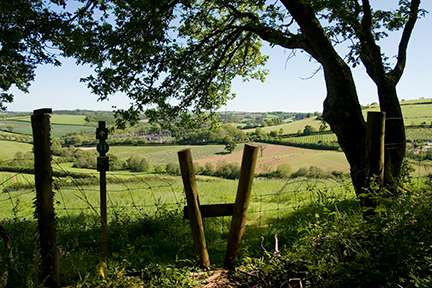There is some nostalgia within green circles for the 1940s, mainly because the war and subsequent rationing imposed a healthy diet (by modern standards) and very low tolerance of waste. But the forties were austere, and many Europeans spent the first half of the decade trying to kill one another, and the second half hungry. The fifties, by contrast, maintained many of the environmentally benign habits of the previous decade while providing an altogether better standard of living, not for everybody perhaps, but for the bulk of the population. ‘Most of our people have never had it so good,’ Harold Macmillan proclaimed in 1957. This was hardly a radical achievement after twenty years of slump, war and rationing. Meanwhile social attitudes only shifted slowly over the decade and life could be more complicated if you were black, or gay, or female or a child born out of wedlock.
Like 80 per cent of British households in the 1950s, my parents did not own a car, nor did they aspire to. Neither of them learnt to drive. This was no handicap even when we lived some distance into the Sussex countryside. Southdown provided an hourly bus service along main rural roads. There were no bus stops; you could hail them anywhere except on a blind corner.
They connected with a railway service that had not yet been eviscerated by Marples and Beeching. We could get from our rural home outside Lewes to London’s Victoria Station in about an hour and a half, which is roughly how long it takes today. Most rural kids got to school by walking to the bus clutching a penny-halfpenny for the fare. There was no school bus because there was a regular omnibus; and there was no traffic congestion round the school gates at 9am and 3pm because the ‘school run’, which interrupts the day for so many modern parents, didn’t exist.
Meanwhile bulky goods were supplied by delivery. The milkman came daily, the postman came twice a day, and the jolly baker came twice weekly. The grocer, greengrocer, butcher and coalman all delivered to order. A shopping expedition with my mother in Lewes included placing orders at the grocer and the greengrocer, which would be delivered later that day so she didn’t have to lug it back on the bus.
In towns, where shops were closer, deliveries were unnecessary, apart from the daily milkman, and the horse-drawn coalmen, who loaded black hessian sacks of anthracite onto their back from their dray and lugged them up garden paths. Sometimes they took a break at the end of the street, munching smutty sandwiches while the horse ate from a nosebag.
Another daily visitor was the paper boy who brought the news and comment that people now find online, and promptly enough. As a reporter, my father could cable in a story in the afternoon from somewhere like Addis Ababa, which would be recorded by shorthand typists, laid out in letterpress, printed in Fleet Street, sent out by night train, and delivered by lads on bicycles to millions of households the next morning.
The dustbin men came as well, though it is doubtful how much they had to take away beyond dust and ashes. There wasn’t a great deal of packaging and none of it was plastic. Bubble packs, polystyrene fill, and other such pointless irritations didn’t exist, nor did the plastic bags that society is now trying to ban; every housewife had her shopping bag.
Dry items were normally sold in paper that could be used to light the fire. Biscuits were sold loose from large tin boxes on display at grocers, from which they were weighed into brown paper bags – a bonus for well-behaved children on shopping expeditions, who might be awarded a broken biscuit by the shopkeeper. Items such as fish and chips, and hardware were wrapped in yesterday’s newspapers.
Glass milk bottles were washed and left out for the milkman. You could reclaim the deposit on beer and pop bottles and soda syphons, though this wasn’t the case with lesser items such as ketchup bottles. Baked bean and sardine tins were much the same as they are now, but items such as coffee, milk powder, tobacco and posh sweets were sold in reusable tins and those that survive now command a good price in antique shops.
Dustmen in those days didn’t do recycling, other than totting, the unofficial recuperation of items of value. In towns, large-scale recycling was performed by another horse-drawn character, the rag and bone man, who would announce his presence outside houses with his eponymous cry, ‘Rag ’n’ bone … any old iron?’ Bones were used for making glue, gelatine, fertilisers and a number of other commodities, while metals were recycled much as they are today.
Rags went for rough materials such as blankets and carpet underlay, and also for making paper. The majority of jettisoned clothes were made from natural materials – wool, cotton, linen and silk – and so could easily be recycled, unlike synthetic materials such as nylon, polyester and acrylic, which were just beginning to hit the market. These now result in about three hundred thousand tonnes of landfill and incinerated waste a year in Britain and are responsible for the spread of plastic microfilaments throughout the oceans.
Going to Seed: A Counterculture Memoir by Simon Fairlie (£14.99, Chelsea Green Publishing) is out now. Simon will appear in conversation with Guy Singh-Watson in an upcoming event hosted by Wicked Leeks, in a discussion about activism, food and the environment. For tickets, click here.










Our way of life has changed dramatically, no going back though. Up to us to reinvent ourselves
Those were the days! I’m sure life was hard – but so much more rewarding.
I keep saying how nice it would be, to be able to go back to that time – a slower pace of life, concentrating on the important things & enjoying more of a community.
None of these chem trails, that the sky is full of these days either!
Excellent recounting of a time that was in time with itself – Society functioned then because women were the unpaid enablers who were expected to underpin the dynamic.
In 50 years time I wonder what we’ll feel nostalgic about the current times? The ritual of the city commute? Remember when we used to eat REAL meat! Maybe we’ll look back at how small the organic sector were? Who knows…
I remember it all – plus the ice cream pony and trap, spending hours edging wallpaper, collecting the cardboard milk bottle tops and getting hours of fun from them and the wallpaper edging. The penny busfare which could be spent on the bus or an Oxo cube (and walking to school).
– and a lot more ………….
Oh my goodness, I remember so well this period. I find when I look back that people were much more contented. Yes life was tough for our patents, money was always tight, but little treats meant so much. People didn’t expect so much, as now everyone must have this and that regardless if you could afford it.
The delight of sitting around the fire chatting, no 24hour T.V. then. People connected and talked to one another., and the best toast you have ever tasted. Sundays were special, if dad wasn’t working, (he was a steel worker) but the shops were closed and it was a family day.
I know we can never get those times back and things move on, but what is worrying is that there never seems to be family time, Sunday lunch is something we do whenever possible, it’s so important to eat together. It doesn’t have to be lavish, just get everyone involved.
Jude, sounds divine, I’m sure it’s human nature but I always wonder if that’s how nostalgia works? Are we just polishing up the past, remembering the good bits & leaving out the bad? Indeed i wonder what we’ll be looking back at these times and thinking that we took this and that for granted…